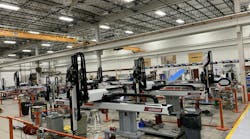By Karen Hanna
Over the last couple years, Pittsfield Plastics Engineering LLC has been on a capital spending binge — with millions of dollars in renovations and machinery investments. But for the company’s leaders, it’s the people designing the molds and running the presses who truly make the difference.
“I think that rather than looking at the number of machines that we’ve purchased, or the number of square feet that we’ve increased, it’s more about the quality of the equipment that we have, and the type of equipment that we have and the type of people in facilities that we have,” plant manager Eric Haddad said.
Amid an ongoing labor shortage, he and other Pittsfield Plastics executives freely acknowledge that their company’s success starts with its employees. That outlook is in line with the views of human resources (HR) experts who are urging companies to pay more heed to their needs of their workforce — even if that requires rethinking issues like retention and professional advancement.
As Julie Davis, VP of people strategy at the Association of Equipment Manufacturers (AEM) puts it, “You can’t just talk business strategy, if you’re not including your talent strategy with that.”
But, she warned, “Doing what you’ve always done is not going to even get you what you used to get.”
Labor churn
Recent surveys of manufacturers and other employers underscore the urgency of a holistic HR approach, at a time when the number of unfilled manufacturing jobs continues to hover around 600,000.
For example, according to a report released in September by the Manufacturing Institute and Forvis, a public accounting firm, 86.6 percent of employers surveyed said they were struggling to fill jobs.
Meanwhile, 22 percent of manufacturing respondents to a survey by Grant Thornton, a global consulting firm, said they have switched jobs in the past year, and 24 percent reported they are likely or extremely likely to do so in the coming year. If the right opportunity came along, 74 percent of manufacturing workers expressed at least some interest in making a switch.
But the grass isn’t always greener — of employees who rated their organization’s culture as good or excellent in a Society for Human Resource Management survey, 83 percent were less likely to actively look for a new job.
The turnstiles, though, are spinning — for all kinds of jobs at all levels, according to Bob Hersh, national managing principal of manufacturing for Grant Thornton’s New York and New England business advisory services.
“The underlying assumption is that those are all jobs [that] are sort of like shop floor or factory floor type of openings, and that’s not true. It’s across the entire career continuum, from the shop floor to the C-suite,” he said.
As plants continue to unlock the capabilities of Industry 4.0 technologies, Hersh is particularly concerned about the growing need for new kinds of manufacturing workers — people with expertise in data analytics, artificial intelligence and other high-tech skills.
Given the competition for the entire spectrum of jobs throughout plants, he offered this profile of companies that will be able to meet their labor needs — the ones “that are the most creative around their automation efficiency, and getting the right people ... in house, showing them the right training, the right career path, the right economic rewards to retain them and have them grow over time.”
Continuous investment is a must, he said.
Realizing the value of human capital
Despite the labor-availability challenges, Pittsfield Plastics has grown in stops and starts throughout the post-COVID-19 pandemic period, from about 65 workers to about 110.
To accommodate additional people and burgeoning orders, Pittsfield Plastics has added 9,000 square feet of warehouse space, an outdoor employee break area and 25 new parking spaces to its campus in Pittsfield, Mass., where it makes plastics spools as well as custom molded products.
Other investments include an enterprise resource planning (ERP) system and better materials-handling technologies.
The company has made “upgrades all the way around,” said CEO/CFO Bruce Dixon, who has been with the company around 13 years. Improvements have included “bringing in better, stronger supervisors and managers.”
Over time, the company has zeroed in on the type of person who can flourish in its culture.
“What we’re looking for is people that take pride in their work and like to grow and are enthusiastic, ambitious and kind of take pride in the fact that what they’ve accomplished, certainly individually, but as a team,” Dixon said.
As it found ways to leverage the comprehensive insights available from its ERP system, the company expanded its leadership team, recalled Haddad, who said he has seen leaders’ approach change for the better in his eight years at the company.
According to Haddad, Pittsfield Plastics now has “a resource manager, a sales manager, a plant manager, an operations manager, a quality manager — all these various managers to then discuss things with each other and bring the different departments of the business together.”
The leadership team’s growth has led to greater communication, Haddad and Dixon said.
“We try to integrate and work as a team with production, which frankly, there used to be silos in this organization 10 or 13 years ago, like in any company. I mean, it’s not just this one,” Dixon said. “We get away from the silos and, frankly, the ERP system kind of almost forces or lends itself to bringing different units and divisions and areas together, to kind of work together [as] one group.”
According to Davis, companies that have evolved from strictly top-down leadership to an approach that leverages everyone’s insights and perspectives have an advantage.
But it means looking at workers — even those at the lowest levels — differently.
“It creates the opportunity for additional innovation that comes from people who are actually dealing with the problems in the front line,” she said. “I think a lot of this is also going to be a shift in leadership mindset, to, ‘Where is the opportunity to have creative solutions?’ … that idea that people who are working on the front line are also problem-solving human beings, who should probably have a voice, and looking at what’s going on and then leveraging that collective creativity in innovation.”
As Nick Roth, Pittsfield Plastics’ national sales manager, observed, “You can’t get stuff done in this business by yourself. You have to have a good team around you.”
Pittsfield Plastics is growing. But the evidence isn’t just in floor space. The culture is changing, too, agreed its executives.
“I’ve been here over 14 years,” said Roth, who describes himself as someone interested in two things: teamwork and morale.
“I started when it was more of like a mom-and-pop shop, and things were different. And then Bruce came on board, and we became more of a professional organization. … I’ve watched the majority owner of the company do nothing but reinvest into the company, especially in these last few years. I mean, if you came to our facility six months ago, and then came now, you would be like, ‘Wow, this is amazing what these people have decided to invest into this company.’ ”
Contact:
Association of Equipment Manufacturers, Milwaukee, 414-272-0943, www.aem.org
Grant Thornton LLP, Boston, 617-723-7900, www.grantthornton.com










